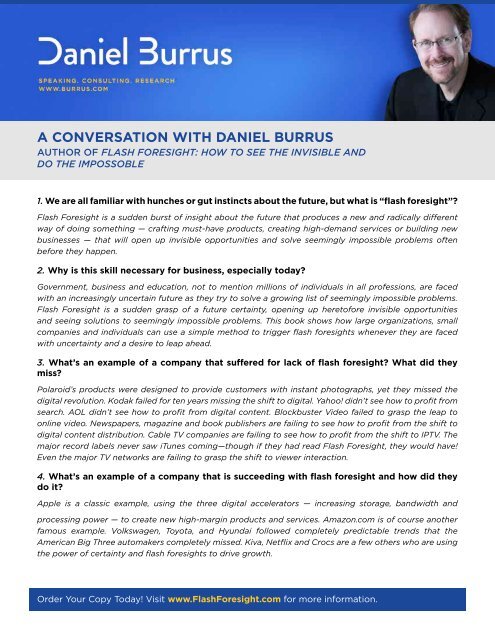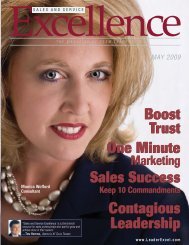Download the Flash Foresight FAQ - Daniel Burrus
Download the Flash Foresight FAQ - Daniel Burrus
Download the Flash Foresight FAQ - Daniel Burrus
Create successful ePaper yourself
Turn your PDF publications into a flip-book with our unique Google optimized e-Paper software.
A CONVERSATION WITH DANIEL BURRUS<br />
AUTHOR OF FLASH FORESIGHT: HOW TO SEE THE INVISIBLE AND<br />
DO THE IMPOSSOBLE<br />
1. We are all familiar with hunches or gut instincts about <strong>the</strong> future, but what is “flash foresight”?<br />
<strong>Flash</strong> <strong>Foresight</strong> is a sudden burst of insight about <strong>the</strong> future that produces a new and radically different<br />
way of doing something — crafting must-have products, creating high-demand services or building new<br />
businesses — that will open up invisible opportunities and solve seemingly impossible problems often<br />
before <strong>the</strong>y happen.<br />
2. Why is this skill necessary for business, especially today?<br />
Government, business and education, not to mention millions of individuals in all professions, are faced<br />
with an increasingly uncertain future as <strong>the</strong>y try to solve a growing list of seemingly impossible problems.<br />
<strong>Flash</strong> <strong>Foresight</strong> is a sudden grasp of a future certainty, opening up heretofore invisible opportunities<br />
and seeing solutions to seemingly impossible problems. This book shows how large organizations, small<br />
companies and individuals can use a simple method to trigger flash foresights whenever <strong>the</strong>y are faced<br />
with uncertainty and a desire to leap ahead.<br />
3. What’s an example of a company that suffered for lack of flash foresight? What did <strong>the</strong>y<br />
miss?<br />
Polaroid’s products were designed to provide customers with instant photographs, yet <strong>the</strong>y missed <strong>the</strong><br />
digital revolution. Kodak failed for ten years missing <strong>the</strong> shift to digital. Yahoo! didn’t see how to profit from<br />
search. AOL didn’t see how to profit from digital content. Blockbuster Video failed to grasp <strong>the</strong> leap to<br />
online video. Newspapers, magazine and book publishers are failing to see how to profit from <strong>the</strong> shift to<br />
digital content distribution. Cable TV companies are failing to see how to profit from <strong>the</strong> shift to IPTV. The<br />
major record labels never saw iTunes coming—though if <strong>the</strong>y had read <strong>Flash</strong> <strong>Foresight</strong>, <strong>the</strong>y would have!<br />
Even <strong>the</strong> major TV networks are failing to grasp <strong>the</strong> shift to viewer interaction.<br />
4. What’s an example of a company that is succeeding with flash foresight and how did <strong>the</strong>y<br />
do it?<br />
Apple is a classic example, using <strong>the</strong> three digital accelerators — increasing storage, bandwidth and<br />
processing power — to create new high-margin products and services. Amazon.com is of course ano<strong>the</strong>r<br />
famous example. Volkswagen, Toyota, and Hyundai followed completely predictable trends that <strong>the</strong><br />
American Big Three automakers completely missed. Kiva, Netflix and Crocs are a few o<strong>the</strong>rs who are using<br />
<strong>the</strong> power of certainty and flash foresights to drive growth.<br />
Order Your Copy Today! Visit www.<strong>Flash</strong><strong>Foresight</strong>.com for more information.
5. What gives you credibility as an expert on this topic?<br />
My specialty as a technology futurist and innovation strategist is discovering “invisible” trends, and solving<br />
“impossible” problems by seeing “invisible” solutions. I’ve been doing this for over 25 years in my work<br />
with <strong>the</strong> world’s leading corporations, entrepreneurs and global movers and shakers. To <strong>the</strong> amazement<br />
of my clients, I consistently provide <strong>the</strong>m with flash foresights, allowing <strong>the</strong>m to both see <strong>the</strong> future with<br />
certainty and clarity, and solve seemingly impossible problems, sometimes in minutes. Almost always,<br />
consulting clients, as well as thousands of audience members, would come up to me and say; “I wish I could<br />
think like you do, I wish I could learn to see <strong>the</strong> future and solve problems like you.” The teacher in me<br />
wanted to know if what I was doing often taking in my mind almost reflexively, could be taught to o<strong>the</strong>rs as<br />
a systematic process. I spent several years reverse-engineering this predictive and strategic process, laying<br />
it out in a systematic, easy-to-understand approach that anyone could follow and duplicate immediately.<br />
The result is my book, <strong>Flash</strong> <strong>Foresight</strong>.<br />
6. Why is it important to “Go Opposite” i.e., do <strong>the</strong> opposite of what my competitors are doing,<br />
when we have to assume that in perfectly competitive markets <strong>the</strong>y have all <strong>the</strong> information<br />
we have?<br />
I don’t like to compete in <strong>the</strong> traditional way. I don’t like <strong>the</strong> odds. I don’t want to do what my competition<br />
is already doing, I want to do what <strong>the</strong>y’ve never thought of doing before. In <strong>the</strong> course of starting six<br />
successful companies, I’ve found that <strong>the</strong> best way to discover unseen opportunities is to look in <strong>the</strong><br />
opposite direction from where your competitors are looking, and <strong>the</strong> entire industry for that matter. For<br />
example, if you are a small retailer, <strong>the</strong> only way to beat Walmart is to do <strong>the</strong> opposite of what <strong>the</strong>y do –<br />
have better service and higher-end products.<br />
7. In <strong>the</strong> book, you state that “When you are operating out of hindsight, you never see it<br />
coming.” By contrast, you argue that we should cultivate a “future view.” Why is this important<br />
for companies and for problem solving in general?<br />
You cannot change <strong>the</strong> past, but you can shape <strong>the</strong> future based on <strong>the</strong> actions you take today. Understanding<br />
that how you view <strong>the</strong> future shapes how you act in <strong>the</strong> present, and how you act in <strong>the</strong> present shapes<br />
your future, it is vital to have an accurate view of what is both possible and certain when looking ahead.<br />
8. Why is it crucial to know <strong>the</strong> difference between soft vs. hard trends when it comes to<br />
forecasting <strong>the</strong> future? And can you include an example or two?<br />
Soft trends might happen, hard trends will happen. Knowing what will happen next provides a powerful<br />
competitive weapon, as well as saving time and money. In 2000, <strong>the</strong> u.s. government was predicting a trilliondollar<br />
surplus, a soft trend that didn’t happen. Many state and local governments based <strong>the</strong>ir spending on<br />
that soft trend and are still paying for <strong>the</strong>ir costly mistake. Apple knew that increasing processing power,<br />
bandwidth and storage on mobile devices was a hard trend; <strong>the</strong>y designed <strong>the</strong>ir forward-looking strategies<br />
around this trio of hard trends and profited greatly.<br />
9. How has <strong>the</strong> ability to tap into flash foresight helped you in <strong>the</strong> course of your career? Could<br />
you share some examples?<br />
As I was writing <strong>the</strong> book, which was <strong>the</strong> bottom of <strong>the</strong> global recession, I started a new business using all<br />
seven principles. One week after launching <strong>the</strong> first products, we were featured in <strong>the</strong> Wall Street Journal<br />
as we disrupted an industry and established ourselves as a national leader. Over <strong>the</strong> past thirty years, I have<br />
started six companies; three were national leaders in <strong>the</strong> first year and all were profitable in <strong>the</strong> first year<br />
using <strong>the</strong> seven principles, so <strong>the</strong>y are time-tested principles.<br />
Order Your Copy Today! Visit www.<strong>Flash</strong><strong>Foresight</strong>.com for more information.
10. What are some examples in <strong>the</strong> news of companies that could benefit from flash foresight?<br />
Hospitals, school systems, newspaper, magazine and book publishers, local and state governments are all<br />
good examples of organizations that are facing seemingly impossible challenges that could find solutions<br />
and new opportunities using <strong>the</strong> seven principles of flash foresight. Energy companies and health care<br />
delivery are two huge industries that desperately need flash foresight. The debate over health care is<br />
mostly about who pays for it — but what we need to be radically transforming is <strong>the</strong> it itself! I go into this<br />
at some length in <strong>the</strong> book, because it’s so important today.<br />
11. Outside of corporate contexts, how can flash foresight be used by governments or nonprofits<br />
to solve social problems? Do you see any evidence of <strong>the</strong> successful use of flash foresights in<br />
<strong>the</strong>se areas?<br />
Governments and non-profits all face seemingly impossible challenges, such as funding needed projects.<br />
<strong>Flash</strong> foresight provides seven powerful tools to see new opportunities for funding and growth. One example<br />
was a school district facing budget cuts, which used processor-sharing to turn all of <strong>the</strong>ir PCs after hours<br />
into a supercomputer for a drug company, generating needed capital. In <strong>the</strong> book I also look extensively at<br />
education and how it could benefit, even be transformed, by <strong>the</strong> application of flash foresight.<br />
12. The idea that technology can serve as a time-saver has been around forever. What are you<br />
saying that’s new?<br />
Corporate America, as well as education America, healthcare America, and all <strong>the</strong> o<strong>the</strong>r different parts of<br />
America, are mostly doing all <strong>the</strong> same thing with new tools that <strong>the</strong>y did before with <strong>the</strong> old tools, except<br />
<strong>the</strong>y’re doing it a little faster. In <strong>the</strong> meantime, we’re wondering why we can’t win, why our economy is in<br />
trouble. It’s time to change <strong>the</strong> way we think about <strong>the</strong> future and how to use technology as tools to create<br />
new products, services, markets and careers.<br />
13. Thanks to <strong>the</strong> economic crisis and global recession in 2009, many companies have been<br />
using technology to downsize and streamline <strong>the</strong>mselves as never before. How can you create<br />
jobs in a downsized world?<br />
Technology can be used to eliminate jobs in an effort to be more efficient and reduce overhead. <strong>Flash</strong><br />
<strong>Foresight</strong> shows <strong>the</strong> reader how to use technology-driven trends to create jobs by creating <strong>the</strong> new<br />
products and services that will drive our economy forward.<br />
14. Can you elaborate on <strong>the</strong> concept of tomorrow labs? How can it help both individuals and<br />
organizations solve problems?<br />
We all spend too much time managing crisis and putting out fires. In a world of transformational change,<br />
it is imperative to have a small group within <strong>the</strong> organization freed to dedicate consistent periods of time<br />
to focus on creating <strong>the</strong> future products and services of <strong>the</strong> organization. We can’t leave this to our “spare<br />
time,” because nobody has any! The only way it will happen, <strong>the</strong> only way we can actually look into <strong>the</strong><br />
future and shape our future with intentionality, is if we actually book it into our schedules and prioritize it<br />
with blocked-out appointments.<br />
15. Why do you say we should take our biggest problem and skip it?<br />
The problem you’re having trouble solving is <strong>the</strong> wrong problem — that’s why you haven’t solved it yet.<br />
They only way to find <strong>the</strong> real problem is to skip <strong>the</strong> one you think you have. You need to learn how to peel<br />
back <strong>the</strong> layers, like peeling an onion, through deliberate inquiry, until you identify <strong>the</strong> correct problem and<br />
underlying opportunity.<br />
Order Your Copy Today! Visit www.<strong>Flash</strong><strong>Foresight</strong>.com for more information.
16. What new trends are you predicting might be on <strong>the</strong> horizon that smart businesses can<br />
profit from?<br />
Technology will transform how we sell, market, communicate, collaborate, educate, train, and innovate<br />
in a short and predictable amount of time. All businesses do all of <strong>the</strong>se activities, and if <strong>the</strong>y are merely<br />
changing, <strong>the</strong>y will fail. The continuing increase in what I call <strong>the</strong> “eight pathways of technological<br />
advancement” — dematerialization, virtualization, mobility, product intelligence, networking, interactivity,<br />
globalization, and convergence — along with <strong>the</strong> accelerating increase in processing power, storage and<br />
bandwidth, will totally transform <strong>the</strong> landscape of business in <strong>the</strong> coming years. Web 2.0 will rapidly make<br />
way for Web 3.0 and Web 4.0, both of which I describe in <strong>the</strong> book, and those who see this coming will be<br />
positioned to profit enormously.<br />
17. What are some quick and simple steps we can start taking tomorrow to put <strong>Flash</strong> <strong>Foresight</strong><br />
principles to work for our own business?<br />
In a world filled with unprecedented uncertainty, ask yourself, what are you certain about? There are<br />
over 300 known cycles that allow you to accurately anticipate <strong>the</strong> future: after winter is spring, after a<br />
recession is a recovery. Linear change, by contrast, is one-way: processing power is getting ever faster,<br />
bandwidth capacity is growing steadily. Yet <strong>the</strong>se trends are just as predictable as cyclic changes: once<br />
we have smartphones with GPs and wireless web, we’re not going back. If you take <strong>the</strong> time you look, you<br />
can pretty readily see what kind of impact just <strong>the</strong>se three digital trends (increasing processing power,<br />
bandwidth and storage) are going to have on your business, your field, your profession or your company.<br />
Starting with those insights, and using some of <strong>the</strong> seven “triggers” I describe in <strong>the</strong> book — go opposite,<br />
take your biggest problem and skip it, and <strong>the</strong> o<strong>the</strong>rs — and you can pretty quickly learn to generate<br />
accurate and powerful flash foresights that uncover hidden opportunities for your own business.<br />
Receive a one-year electronic<br />
subscription to <strong>the</strong> Technotrends<br />
Newsletter with each book purchased.<br />
(List price $29.95, your price FREE with<br />
each book purchased.)<br />
Order Your Copy Today! Visit www.<strong>Flash</strong><strong>Foresight</strong>.com for more information.






